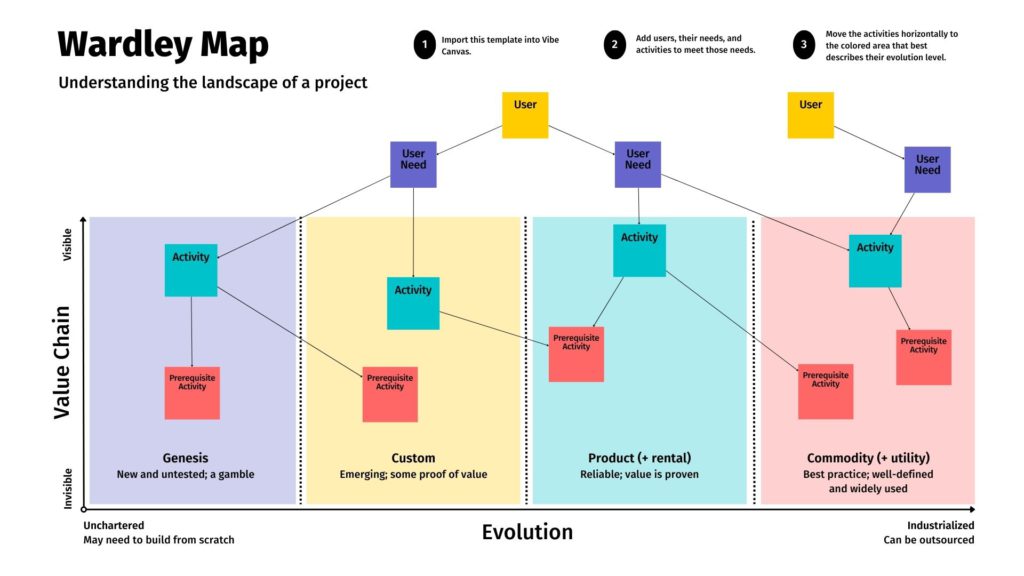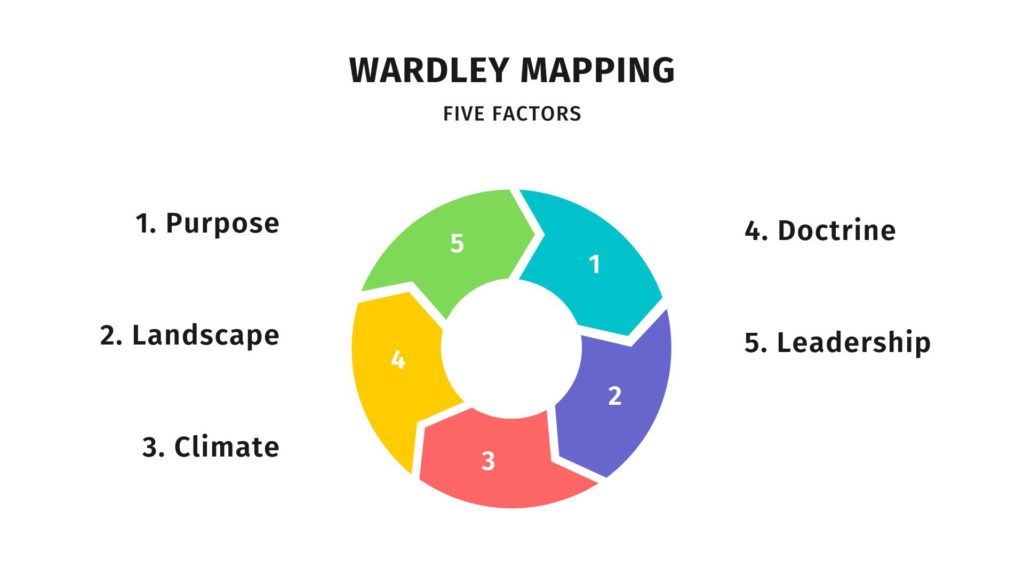No matter what your team is trying to accomplish, a well-thought-out, strategic plan is an essential first step. Overcoming unpredictability is a breeze when you prioritize planned strategies—strategies that predict potential roadblocks and leverage the knowledge your team already possesses. Although some plans could appear foolproof from the outside, they often aren’t well-equipped to fully support your business.
A great place to start is with a technique called the Wardley Map.
What Are Wardley Maps?

A Wardley Map, also known as Simon Wardley Mapping, is a pictorial representation of the environment in which a company functions. It’s a graph showing the relationship between evolution (how activities change with time under supply and demand competition) and the steps along the value chain (the set of tasks necessary to satisfy the demands of the user).
A Wardley Map illustrates the current understanding of a subject and the commonly held beliefs about it, as well as providing indications about potential strategic moves.
The method’s creator, Simon Wardley, believes that the strategy is based on Chinese military general Sun Tzu’s five factors: purpose, climate, landscape, doctrine, and leadership. According to that framework, a successful leader knows what they’re fighting for, why they’re fighting for it, has a firm grasp of the landscape, can foresee the trends of the factors acting on the environment, and instills in their team a set of principles that can be applied in any situation.
How Do Wardley Maps Work?

Unlike static pictures like a SWOT Analysis or Business Model Canvas, Wardley Maps are built on real-time data and the ability to adapt to changing circumstances.
Unlike OKRs or Hoshin Kanri, Wardley Maps are more strategic thinking tools—think brainstorming, but better. You can use this tool to build a plan that has a better chance of success by taking into account the specifics of the situation.
In order to create a successful strategy, you’ll need to focus on the following:
-
A well-defined goal (also known as strategic intent)
-
An understanding of the landscape in which you’re competing
-
The climatic patterns that have a role in shaping the landscape
-
The concepts that are generally relevant regardless of the circumstance (also known as doctrine)
When all of these factors are considered, it’s easy for leaders to address the two most important issues that any strategy poses: where to fight and how to succeed.
Because of its visual nature and sensitivity to the surrounding environment, Wardley Maps make it possible for leaders to easily explain the plan while also allowing people to challenge and work on it.
Benefits of Wardley Mapping

The following are some of the advantages of using the Wardley Mapping method:
-
Enhanced communication across the whole company
-
Improved ability to identify both threats and opportunities
-
Improved functionality of products
-
Better ability to reduce costs
-
Better cooperation between groups operating on all levels
Everyone—from the CEO to the manager of a project—uses strategy to help guide decision-making and avoid making any mistakes. As Simon Wardley puts it,
"Strategy is all about observing the landscape, understanding how it is changing, and using what resources you have to maximize your chances of success."
It’s quite similar to playing a game of chess, except that the board is a map of the landscape.
How to Build a Wardley Map

Mapping can help you validate your team’s best ideas in a timely manner. Thus, with mapping, you have a simple method for preventing expensive errors. It’s useful for figuring out what needs fixing, what to buy, and what to outsource. It’s a very important factor in reducing the likelihood of missing an important detail.
Since creating a map is an evolutionary process, you don’t have to spend too much time creating it. You can always take advantage of new information to make improvements to your map, so don’t let the pursuit of perfection get in the way of making it the first time.
Here’s how you can create a Wardley Map:
Purpose
The first step in creating a Wardley Map is to define your purpose.
Consider the problem you’re facing in your company:
-
Are profits decreasing because of intense rivalry?
-
Are you entering a new marketplace?
-
Are you unable to find success in the market with your current offering?
-
Does it seem like one of your core technology components is becoming more common?
Once the difficulty has been identified, you must devise a strategy for overcoming it.
If you don’t have a good map, you’ll be unable to see how the climate is going to affect the landscape or predict the movement of your competitors, both of which are crucial for planning attacks.
Landscape
Building a Wardley Map is similar to building a topographical map. It requires a close examination of the landscape. For example, if you were to make a map of Florida without the marshes and lakes, it wouldn’t be nearly as helpful or accurate as a map that included them.
In the landscape of the Wardley Map, the user’s wants and requirements serve as the compass. Your auxiliary resources are a value chain of capabilities essential to meet the demands of your customers. You’ll plot features on a Wardley Map according to how the user can see them and how far along in development they are.
An exact map requires:
-
Figuring out who your target audience is. Make room for the customer on the map.
-
Learning about the prerequisites you must fulfill. Make branches off of the user’s main trunk to list their demands.
-
Identifying the skills that’ll be needed to address such issues.
-
Checking the developmental status of each capability.
Climate
Climate is the rule that impacts the whole game. Understanding the climatic patterns enable us to see the evolution process of the landscape.
As part of the examination process, you should try to determine the prevailing climate patterns: What are the driving factors that affect all of the major players and potentially change the landscape forever?
It might be due to a number of factors, including rivalry in the market caused by supply and demand, advances in technology, or the advent of industrialization.
These recurring events have an effect on your strategies whether you want it or not. Thus, it’s in your best interest to be alert to and prepared for them.
Doctrine
When it comes to educating employees about your organization’s unique climate, there’s nothing better than a solid foundation of doctrine. Choose an approach that works for your company and stick to it.
The key to getting more consistent results from your team practice is to train them in the same method over and over again. When everyone in a company adopts the same technique, it’s like speaking the same language; everyone can communicate with one another.
Leadership
Here, we face the "battle at hand." At this stage, leaders should consider the other four criteria that will go into making your map.
For example, in order to bake a loaf of bread, one must do more than simply switch on the oven—even though it’s the main step that ultimately bakes the bread. There are a number of variables at play, including the kind of flour used, the amount of time allowed for the dough to rise, and the relative humidity in the air. If you neglect to consider any one of these factors, your bread will most likely fail.
The same applies to leadership; You’ll have less efficiency if you don’t consider every factor that might influence the outcome you want.
Therefore, using a Wardley Map is effective in getting started on each of these five elements in your company plan.
Build Your Wardley Map with Vibe

Vibe is an interactive whiteboard device that allows you to create Wardley Map using a well-devised template and collaborative tools. Vibe helps you develop a winning business strategy and make more informed business choices with real-time collaboration, one-click video conferencing, and an infinite whiteboard perfect for creating big strategies.
Brainstorming with an interactive whiteboard makes creating Wardley Maps simple and straightforward, so you can better emphasize potential successes and facilitate better communication among your team.
Get started with Vibe today!
FAQs
-
Are Wardley Maps easy to make?
With interactive whiteboard software, creating Wardley Maps is incredibly easy! Make sure you have a clear idea of what to include in each step. Here’s what to include:
-
Determine your goal and the requirements of your target audience.
-
Limit the scope by analyzing value chains.
-
Connect the value chains.
-
Examine differences and similarities.
-
What is the purpose of a Wardley Map?
Wardley Mapping is a free resource for understanding your environment and making future-proof plans for success. You may use a Wardley Map to guide your way through the strategy lifecycle and get insight into the many factors influencing your situation, including the effect of your own actions.








-1sbltxxq4FYxHrXrwJVLsCDNsXpqNa.webp)
-5Zp0pmSytvcuYDVs1LvuwplKuRneK0.webp)
